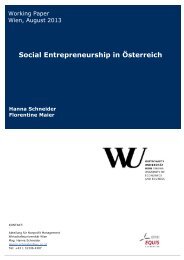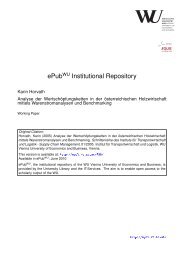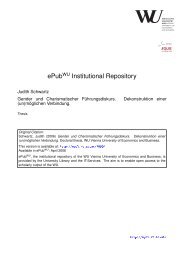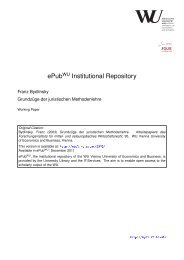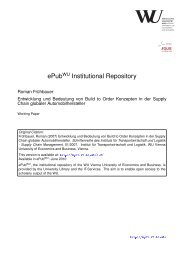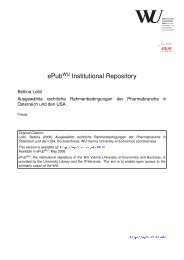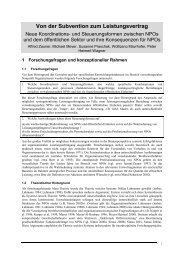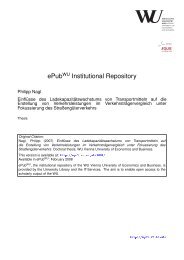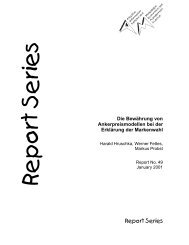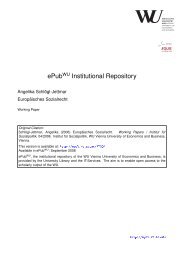Download - ePub WU
Download - ePub WU
Download - ePub WU
You also want an ePaper? Increase the reach of your titles
YUMPU automatically turns print PDFs into web optimized ePapers that Google loves.
<strong>ePub</strong> <strong>WU</strong> Institutional Repository<br />
Jan Kratzer and Christopher Lettl<br />
Distinctive Roles of Lead Users and Opinion Leaders in the Social Networks<br />
of Schoolchildren<br />
Article (Published)<br />
(Refereed)<br />
Original Citation:<br />
Kratzer, Jan and Lettl, Christopher (2009) Distinctive Roles of Lead Users and Opinion Leaders in<br />
the Social Networks of Schoolchildren. Journal of Consumer Research, 36 (4). pp. 646-659. ISSN<br />
0093-5301<br />
This version is available at: http://epub.wu.ac.at/3093/<br />
Available in <strong>ePub</strong> <strong>WU</strong> : May 2011<br />
<strong>ePub</strong> <strong>WU</strong> , the institutional repository of the <strong>WU</strong> Vienna University of Economics and Business, is<br />
provided by the University Library and the IT-Services. The aim is to enable open access to the<br />
scholarly output of the <strong>WU</strong>.<br />
This document is the publisher-created published version. It is a verbatim copy of the publisher<br />
version.<br />
http://epub.wu.ac.at/
Distinctive Roies of Lead Users<br />
and Opinion Leaders in the Social<br />
Networks of Schoolchildren<br />
JAN KRATZER<br />
CHRISTOPHER LETTL*<br />
Prior research has shown that both lead users and opinion leacters may propel the<br />
diffusion of innovation. This raises the question of whether lead users and opinion<br />
leaders are positioned similarly in social networks, which we address using a sample<br />
of 23 school classes consisting of 537 children. Research among children is very<br />
scarce in this particular domain. Our statistical analyses based on hierarchical linear<br />
modeling reveal two general results: first, lead users among children appear to possess<br />
a variety of links between clusters; second, opinion leaders are locally positioned<br />
within clusters of children and have many direct links.<br />
Generating truly novel product ideas that are attractive to<br />
large market segments is one of the most significant<br />
challenges at the "hi/.zy front end" of new product development.<br />
In addition to tapping internal sources, companies<br />
need to identify suitable external idea generators as well as<br />
customers wbo are capable of propelling the adoption and<br />
diffusion of each new product. The literature on new product<br />
development (NPD) suggests several strategies to generate<br />
ideas for truly new products, including techniques such as<br />
benchmarketing (Ulrich and Eppinger 20(X)). user observation<br />
(Leonard and Rayport 1997). analogical tbinking (Dahl and<br />
Moreau 2002; Srinivasan, Lovejoy. and Beach 1997), and tbe<br />
lead user approach (von Hippel 1986). Among those techniques,<br />
the lead user approach has received tbe greatest empirical<br />
support as a driver of commercially attractive and<br />
highly novel product ideas (Franke, von Hippel. and Schreier<br />
2006; Lilien et al. 2002; Morrison. Roberts, and von Hippel<br />
2000; Scbreier. Oberbauser. and Prügl 2007). Lead users are<br />
described as those wbo are ahead of an important maiket<br />
trend, who expect high benefits from innovating, and wbo<br />
*Jan Kralzer is professor of entrepreneurship and itinovation managemeni.<br />
Berlin University of Technology. Strasse des 17. Juni 135. Berlin.<br />
10623 Germany (jan,krauer@tu-berlin,de). Address correspondence to Jan<br />
Kratzer- Chrisiopher Letil is professtir of innovation managcmeni. University<br />
of Aarhus. Aarhus, Denmark (letll@asb,dk) and from July 2{X)9<br />
will be professor of enirepreneurship and innovation, Vienna Univensily<br />
of Economics and Business Administration. Vienna. Austria (Christopher<br />
.Letti@wu-wien.ai;.at), The authors acknowledge the helpful input of the<br />
ediEor. the associate editor, and the reviewers.<br />
John Deighton served as editor and Brian Ratchford sen-ed as associate<br />
editor for this article.<br />
Electronically puhli.'ihed April 10, 2009<br />
will therefore be most likely to develop commercially attractive<br />
innovations (von Hippel 1986).<br />
Lead users may be involved not only at tbe "fuzzy fi-ont<br />
end" but also at later stages of the NPD process because<br />
they are also the first to test and use their self-designed<br />
prototypes (von Hippel 2005). Thus, lead users may also<br />
serve as role models for otber users witbin social networks<br />
at very early stages of adoption, and they may therefore<br />
gradually migrate into the role of opinion leaders who contribute<br />
to tbe diffusion of tbeir innovations (Rogers 1976;<br />
Schreier et al. 2(XJ7). Similar to lead users, opinion leaders<br />
are considered to be more innovative and creative (Cbilders<br />
1986). to be more involved and more familiar witb products<br />
(Cban and Misra 1990). and to have more use experience<br />
and expertise (Venkatramun 1989) tban tbe average user,<br />
Consequently, the question arises, are lead users and opinion<br />
leaders merely two sides of the same coin? Since bodi generating<br />
novel product ideas and diffusing innovations are determined<br />
by itidividual network positions (Burt 2004; Rogers<br />
1976). tbe general purpose of our research is to investigate<br />
whether lead users and opinion leaders have distinctive network<br />
roles.<br />
On the basis of prior work on lead users and opinion<br />
leaders, insigbts on problem solving from cognitive psychology,<br />
and researcb on creativity, network theory, and<br />
innovation diffusion theory, we develop hypotheses on the<br />
distinctive social network positions of lead users and opinion<br />
leaders. In order to test our hypotheses, we apply a hierarchical<br />
linear modeling approach in an empirical study<br />
among 23 school classes with a total of 537 pupils. In particular,<br />
research investigating network characteristics of lead<br />
users and opinion leaders among children is scanty in the<br />
646<br />
e 2009 by JOURNAL OF CONSUMER RESEARCH, Inc • Vol. .16 • December 20O9<br />
All rights reserved 0O93-53UI/2O09/36Ü4-IXI03S10.0Ü. DOI: 10.1086/59^324
NETWORK SIDE OF LEADING EDGE CONSUMERS 647<br />
literature. We find that lead users and opinion leaders do<br />
have distinctive network roles. Bridging diverse local groups<br />
increases one"s likelihood of being a lead user, wbile acting<br />
;is a hub witbin local groups increases the likelihood of being<br />
an opinion leader. In the next section, we develop our study's<br />
conceptual underpinnings and research questions. We then<br />
develop our hypothe.ses. describe the method used to test<br />
them, and present our results.<br />
THEORETICAL FRAMEWORK AND<br />
RESEARCH QUESTIONS<br />
Interest in the children's consumer market has grown considerably<br />
in both academic literature and the business worid.<br />
McNeal ( 1992) identified cbildren as representatives of three<br />
markets in one: a primary market spending its own savings<br />
or allowances; a .secondary market of "influencers" of mainly<br />
piuvntal spending; and a tertiary, future market of potential<br />
adult consumers.<br />
Besides this market transaction perspective on children,<br />
an innovation perspective has also come to light. Children<br />
are very often inventors themselves, developing new product<br />
concepts that are relevant to many of their peers and sometimes<br />
even to adults. One example is Michael Oliveras, an<br />
1 I-year-old from Brooklyn, who needed to fly frequently<br />
to see his parents and thus designed a special headrest for<br />
use on airplane seats. Tbe headrest fastens to tbe side of the<br />
seat so that, when passengers fall asleep, their heads do not<br />
come to rest on the shoulder of the person next to them.<br />
Oliveras received an award for his invention from the National<br />
Patent Model Association (New York Times, May 1.<br />
2001). More and more firms have begun to leverage the<br />
imagination and creativity of children for new product development;<br />
children have been developing new building<br />
models for LEGO and new computer game features for game<br />
producers (Jeppesen and Molin 2003). Acknowledging tbe<br />
higb potential of children as inventors, the U.S. Patent and<br />
Trademark Office (USPTO) launched a national campaign<br />
together witb the Advertising Council and the National Inventors<br />
Hall of Fame in April 2007 to promote innovation<br />
by children more systematically (see http://www.uspto.gov).<br />
As children lack past experience and well-establisbed cues<br />
as to the quality or functionality of products, the interpersonal<br />
exchange of information becomes extraordinarily important<br />
(Hanson and Putler 1996; Moore and Lutz 2000).<br />
This exchange of information, or word of mouth (WOM),<br />
is the most important informal means of communication<br />
among consumers (Derbaix and Vanhamme 2003). The<br />
WOM networks among children may be important to innovation<br />
activities for two reasons: first, children may be<br />
involved in tbe product development process itself as tbey<br />
possess need and use related knowledge as consumers; second,<br />
children may also influence each otber in decisions to<br />
adopt innovations.<br />
Word-of-mouth networks may place these young users at<br />
the leading edge of innovation for two reasons: first, networks<br />
provide a social framework for cbildren in which<br />
they can excel and gain a reputation for certain abilities<br />
within their peer groups (Jeppesen and Molin 2(K)3; Zeiler<br />
et al. 2003); second, networks provide innovative children<br />
with instant feedback as to whether tbeir proposed ideas are<br />
"cool" and cutting edge. Altbough there is a growing body<br />
of empirical researcb on the lead user concept, the position<br />
of lead users in their social networks has noi yet been studied<br />
in depth (either in "adult" or "child" research). However,<br />
deeper insight into the social network ptjsition of lead users<br />
is crucial for gaining a better understanding of tbe nature<br />
and emergence of lead users. So far. research on lead users<br />
has focused on tbe concept itself (von Hippcl 1986), its<br />
implementation in companies (Luethje and Herstatt 2004),<br />
and its empirical validation by surveying user populations<br />
in various industries (Franke et al. 2{)O6).<br />
Building on tbe work of Whyte (1954). who first conceptualized<br />
WOM, Katz and Lazarsfeld U965) stressed the<br />
idea that opinion leaders can accelerate the diffusion of<br />
innovations. According to Gladwell (2002). 10% of people<br />
determine the adoptive behavior of the remaining 90% by<br />
WOM. Likewise, other studies emphasize the important role<br />
of opinion leaders as information distributors (Czepiel 1976;<br />
Summers 1970; Valente 1996) and the fact that the diffusion<br />
of innovations is often initiated by a relatively small .segment<br />
of opinion leaders (Coulter. Feick. and Price 2002; Van den<br />
Buhe and Joshi 2007; Watts and Dodds 2007). Research<br />
shows that WOM has an important influence on decisionmaking<br />
processes among cbildren (Hansen and Hansen<br />
2005; John and Lakshmi-Ratan 1992; Spungin 2004). Although<br />
a number of studies on opinion leaders have emerged<br />
in tbe literature on adults, the specific role of opinion leaders<br />
within social networks among children is often overlooked<br />
(Hansen and Hansen 2005). To gather up the threads, our<br />
study is guided by the following central research question:<br />
Can lead users and opinion leaders among children be identified<br />
by the nature of their individual social networks? Or,<br />
in otber words, do lead users and opinion leaders among<br />
children have distinct network roles?<br />
TRANSLATING THE NATURE OF<br />
INDIVIDUAL SOCIAL NETWORKS<br />
INTO LEAD USER AND OPINION<br />
LEADER ROLES<br />
In social networks, it appears that social structures comprise<br />
clustered networks of people with various ties among<br />
tbem (Bandura 20011. These ties, or "weak links," guarantee<br />
the flow of information across network clusters (Brown and<br />
Reingen 1987). First conceptualized by Granovetter (1973).<br />
weak ¡inks refer to links between certain network actors that<br />
provide tbem with information advantages. Since then. Burt<br />
(1992), Freeman (1979) and others have attempted to identify<br />
and characterize the weak links connecting these clusters<br />
in networks. In the most prominent and best-suited conceptualization<br />
of tbis structural configuration. Freeman (1979)<br />
developed the concept of betweenness centrality. Betweenness<br />
centrality can be defined as the number of times that
648 JOURNAL OF CONSUMER RESEARCH<br />
an actor needs a given actor in order to reach another actor<br />
or to be reached by that actor. More precisely, it is the<br />
number of sbortest paths (between all pairs of actors) that<br />
pass through a given actor in a network. This kind of centrality<br />
is not based on the number of ties but on the extent<br />
to which an actorfacilitates the flow of information by being<br />
positioned on many information paths. If an actor with high<br />
betweenness centrality is removed from tbe network, the<br />
speed and certainty of transmission from one arbitrary point<br />
to another are damaged more than in cases where an actor<br />
with low betweenness centrality is removed (Borgatti 1995).<br />
In addition to betweenness centrality. two other measures<br />
are commonly conceptualized in network analysis: degree<br />
centrality and closeness centrality (Borgatti 1995). Tbe degree<br />
centrality of an actor is simply the number of people<br />
with whom she or he has contact, corrected for the total<br />
number of people in a given network. Suppose that the<br />
probability of adopting an innovation or influencing its<br />
adoption is a function of the number of people with whom<br />
an actor is in contact. We can then interpret degree centrality<br />
as a measure of an actor's "risk" of diffusing or receiving<br />
whatever information flows through tbe network.<br />
The third measure is closeness centrality, which may be<br />
defined as a given actor" s total graph-theoretic distance from<br />
all other actors. More precisely, closeness centrality is an<br />
index of the expected time it will take the information to<br />
flow through tbe network in order to reach a given actor.<br />
For example, suppose that new information enters a network<br />
at actor/^ and that it takes one unit of time to traverse each<br />
link. If we assume that the infonnation will always travel<br />
along the shortest possible route, it will reach actor q in dpq<br />
units of time, wbere ¿//JÍ/is the number oflinks in the shortest<br />
path from /) to c/. Admittedly, information does not always<br />
take tbe shortest path to specific actors. However, the length<br />
of the shortest path between two actors is highly correlated<br />
with the average length of all paths between the actors in<br />
a social network (Borgatti 1995), If the new information is<br />
equally likely to follow each possible path, closeness will<br />
usually not be far off the mark.<br />
The Network Role of Lead Users<br />
Lead users are on the leading edge of an important market<br />
trend and have been shown to develop radically new product<br />
concepts and solutions (Lettl. Gemuenden. and Hienerth<br />
2008; Lilien et al. 2002). The main incentive of lead users<br />
to innovate is to find appropriate solutions for their needs<br />
(von Hippel 1986). Lead users tend to combine and reassemble<br />
any type of prior technological knowledge that<br />
brings about a solution best suited to tbeir needs (von Hippel<br />
2005). Insights into archetypal lead user innovations, such<br />
as the first device for gas chromatography. the first surgical<br />
navigation systems, the first medical robot for neurosurgery,<br />
the first biocompatible implant for hernia surgery (Lettl et<br />
al. 2008), and tbe first mountain bike (Luethje. Herstatt, and<br />
von Hippel 2005). reveal that tbe lead user inventor combined<br />
diverse fields of technological knowledge in each ca.se.<br />
This is consistent with research from cognitive psychology<br />
that emphasizes tbe combination of diverse knowledge bases<br />
as a driver of truly innovative thought and radically new<br />
concepts (Dahl and Moreau 2002; Ward 1994).<br />
From a social network theory standpoint. Burt (1992)<br />
argues tbat information access and control advantages are<br />
created when relations bridge groups, wbich does not necessarily<br />
indicate a large number of direct contacts. Actors<br />
with a social network bridging differeni groups tend to monitor<br />
infonnation more effectively and to receive information<br />
more quickly (Staber 2004). As Bun (20(M) suggests, people<br />
positioned near the "boles" in a social structure have a higher<br />
probability of coming up with good ideas. Tbe argument is<br />
that opinions and bebavior are more homogenous within<br />
groups than between groups, so people connected across<br />
groups are more familiar witb alternative ways of thinking<br />
and behaving. This gives them more options to select, interpret,<br />
and synthesize. In addition, people whose networks<br />
.span multiple groups have an advantage in detecting and<br />
exploiting rewarding opportunities. Tlieir advantage is information<br />
arbitrage. They are able to see early and more<br />
broadly (Burt 2004).<br />
The link between the crossing of group boundaries and<br />
lead usemess may also be viewed from the perspective of<br />
•'sticky" information, that is. the idea that knowledge emerging<br />
from practice in groups tends to be tacit in nature and<br />
thus difficult and costly to transfer (von Hippel 1998). Individuals<br />
positioned at the intersections between distant<br />
groups bave exclusive access to a variety of sticky information<br />
sources. This quality has been emphasized by von<br />
Hippel ( 1986, 2005) as a crucial prerequisite for developing<br />
leading edge status. The argument is that individuals with<br />
access to diverse sources of sticky information are in a<br />
superior position to overcome an effect known as functional<br />
fixedness, a phenomenon in which real-world experience in<br />
a particular product class induces individuals to develop<br />
schemata about product features, design, and usage, wbich,<br />
in turn, heavily constrains their capability to develop substantial<br />
innovations witbin that product class (Adamson<br />
1952-, Birch and Rabinowitz 1951). This argumentation<br />
prompts the following hypothesis:<br />
HI:<br />
Tbe higher the betweenness centrality of a child<br />
in his/her social network, the more likely the<br />
child can be identified as a lead user.<br />
The Network Role of Opinion Leaders<br />
Coleman. Katz. and Menzel (1966) and Rogers (1976)<br />
argue that informal social networks provide a better map<br />
for successful diffusion than formal communication networks.<br />
Within social networks, certain roles accelerate the<br />
diffusion of innovation more than others. In this context, no<br />
other role has been paid more attention than that of opinion<br />
leaders.
NETWORK SIDE OF LEADING EDGE CONSUMERS 649<br />
Flynn, Goldsmith, and Eastman (1996) define opinion<br />
leaders as people who directly influence other consumers<br />
by giving advice and verbal directions lor the search, pur-<br />
Lha.se, and use of a product. Research evidence at the smallgroup<br />
level of analysis indicates that being central in social<br />
networks is a signilicant source of influence (Brass and<br />
Biirkhardt 1992). As Barabasi and Bonabeau (2003) point<br />
out, hubs are likely to play a crucial role in the diffusion<br />
OÏ innovation because they occupy a central position in a<br />
specific network. Network hubs refer to those actors in a<br />
network wbo have more contacts than others (Barabasi and<br />
Bonabeau 2003). These hubs may be regarded as the translation<br />
of opinion leadership into a network role as opinion<br />
leadership is generally associated with a higb average number<br />
of network connections (Valente 1996).<br />
Information is most influential through direct and strong<br />
contacts (Brown and Reingen 1987: Weimann 1982). It is<br />
plausible to assume that individuals trust those to whom<br />
they have direct connections. Goldenberg et al. (2008) state<br />
that these trust relationships are closely related to the concept<br />
of homophily, that is. the idea that the people an individual<br />
gets to know are primarily a function of similarity. Researchers<br />
have studied homophily in relationships that range<br />
from close ties such as marriage (Kalmijn 2003) to professional<br />
relationships (Marsden 1988). Once such informal<br />
patterns have been established among actors who share certain<br />
similarities, the resulting networks are characterized by<br />
high stability (Feld 1997; McPherson, Smith-Lovin. and<br />
Cook 2001). Those strong contacts enable the mutual development<br />
of local orientation and coding schemes (Wilensky<br />
1967), which, in turn, make it possible to transfer<br />
contextual cues to purely product-related information. Such<br />
contextual cues are inevitably necessary in order to exert a<br />
normative or informative influence. Building upon tbe influential<br />
nature of opinion leaders, we expect them toexhibit<br />
high popularity within groups characterized by many direct<br />
contact.s, as reflected in high degree centrality. Based on this<br />
argumentation, the following hypothesis can be formulated;<br />
H2: Tbe bigher the degree centrality of a child in his/<br />
her social network, the more likely the child can<br />
be identified as an opinion leader.<br />
It is reasonable to assume that tbere may be more than<br />
one opinion leading individual within a group. As Weimann<br />
(1994) points out, opinion leaders tend to be interconnected,<br />
thus creating a powerful "invisible college" that determines<br />
the adoption or rejection of innovations. When opinion leaders<br />
possess many direct contacts and are also mutually interconnected,<br />
they are considered "close" to all otber group<br />
members. Hence, we expect opinion leaders to show not<br />
only high degree centality but also high closeness centrality,<br />
wbicb leads us to the following bypotbesis:<br />
H3: The higher the closeness centrality of a child in<br />
his/her stKial network, the more likely the child<br />
can be identified as an opinion leader.<br />
RESEARCH DESIGN<br />
Study Design, Procedure, and Participants<br />
In order to address our hypotheses empirically, we gatliered<br />
data from nine randomly selected public .schools in the Netherlands.<br />
Within the schools, we surveyed 23 classes witb a<br />
total of 537 pupils. Jean Piaget ( 1971 ) developed a cognitive<br />
development model witb tour successive stages: the sensory<br />
motor periixl (0-2 years), the preoperational stage (2-7 years),<br />
the concrete operational stage (7-11 years), and tbe formal<br />
operational stage (11-15 years). Piaget (1971) empha.sized<br />
the age of 7 as a major cognitive turning point: around this<br />
age. children make the transition from the preoperational stage<br />
to the concrete operational stage!: they become better at logical,<br />
systematic thought using multiple pieces of information.<br />
In addition, language skills develop and children learn about<br />
ctassiiications. John (1999) sutnmarizes 25 years of research<br />
on Ihe cognitive development of children by extracting three<br />
major phases: the perceptual stage (3-7 years), in which<br />
children are still egocentrically oriented; the analytical stage<br />
(7-11 years), in which children develop a social perspective;<br />
and the reflective stage (11-16 years). We decided to select<br />
children from pupils in three grades, basing our study on<br />
tbe cognitive and social development of children, as suggested<br />
by Piaget ( 1971 ) and John ( 1999), We u.sed a cluster<br />
sample that included children in grade 5 (approximately 8<br />
years old), grade 6 (approximately 9 years old), and grade<br />
7 (approximately 10 years old), attempting to cover children<br />
from a minimum age of 7 to a maximum age of 11. In<br />
reality, the school classes also contained a small minority<br />
of children aged 12 or older as some pupils had stayed back<br />
a year or more. Including tbese pupils in the sample did not<br />
have any effects on the results: in fact, ii even enhanced the<br />
robustness of the network calculations, which are very sensitive<br />
to missing data. Moreover, in order to collect data<br />
about social networks that are not ego-centered (Wassermann<br />
and Faust 1994). it is necessary to define the boundaries<br />
of tbe networks. As children spend a large part of their<br />
day at school (around 6-8 hours per day in tbe Netherlands),<br />
we investigated full networks of school classes, as suggested<br />
earlier (Defares et al. 1971). The full network of a school<br />
class represents a matrix that includes all indications of contacts<br />
among all children within one class. Tbe overall sample<br />
contained 537 children in 23 school classes, with eight classes<br />
from grade 5. six classes froni grade 6. and nine classes<br />
from grade 7. The average size of the school classes was<br />
around 23 pupils. The rese:irch was approved in the university's<br />
buman subject approval process.<br />
Data Collection<br />
Collecting data from children using questionnaires is difficult<br />
because tbeir interpretations of questions and definitions<br />
are often ambiguous. A child's cognitive, communicative,<br />
and social skills undergo a process of development<br />
as she or he grows older, and this affects a child's ability
650 JOURNAL OF CONSUMER RESEARCH<br />
to answer survey questions (Borgers 2003). In order to collect<br />
data about children's social networks, we used the Syracuse-A<br />
tnsterdam-G ron i ngen Sociometric Scale (SAGS; see<br />
fig. Al in the appendix). This method is appropriate for<br />
collecting data that covers full networks of school classes.<br />
The children were asked to complete a matrix in which the<br />
rows showed the names of all classmates and the columns<br />
indicated their frequency of contact. The children thus indicated<br />
how frequently they had contact with each of their<br />
classmates. The frequencies range from "never" to "very<br />
often" on a Likert-type scale. In order to ensure that it was<br />
easily understandable for children, the tiiatrix used symbols<br />
{for more detail, see the appendix) and one researcher was<br />
always present to explain the scale and to answer questions.<br />
With the exception of this special design for children, the<br />
SAGS instrument measures full social networks in a way<br />
similar to the scales used for adults; for example. Cohen<br />
and Cohen (1991) use a similar measurement instrument to<br />
compare networks of children and innovation teams. SAGS<br />
has the advantage of being a reliable and valid instrument<br />
for examining networks of (young) children (Borgers 2003;<br />
Defares et al. 1971).<br />
The questionnaire also contained questions on sociostructural<br />
items, such as gender and age. and batteries of<br />
items to measure lead userness and opinion leadership. The<br />
questionnaire was completed by 519 children, meaning that<br />
the response rate in our study was around 97%. The questionnaire<br />
was designed according to the expert appraisal<br />
coding schedule for questionnaires for children and adolescents<br />
(Borgers 2003).<br />
The item batteries used to identify the extent to which<br />
the children are lead users and opinion leaders are derived<br />
from earlier studies. However, a nutiiber of items had to be<br />
omitted because they were not suited to the cognitive capabilities<br />
of children, for example, items about the monetary<br />
value of products (Chaplin and John 2007). For the same<br />
reason, we also had to minimize the number of items in the<br />
que.siionnaire. A pretest among 45 childreti during the<br />
CineKid FilmFestival 2006 in Amsterdam confirmed our<br />
selection of items. The children understood and were able<br />
to distinguish the items we ultimately included in the<br />
quesfionnaire.<br />
Measures<br />
Measuring the Children's Social Networks. The data<br />
gathered using the SAGS instrument resulted in a matrix<br />
showing the frequency of contact among all of the children<br />
in each class. The original 23 matrices are asymmetric, containing<br />
indications of contact frequencies between all /'s and<br />
/s (labeled out-iinks) and all/s and fs (labeled in-links).<br />
Phrased differently, in-links are the indications about contact<br />
frequency with all other classmates of every child within<br />
one particular class, and contrary out-links are the same<br />
indications of all other classmates, in some cases, the distinction<br />
between these link types is particularly important<br />
because they cannot be interpreted in the same way. In our<br />
study, however, there is no meaningful distinction between<br />
in-links and out-links, as two connected children communicate<br />
regardless of which one sends or receives the information.<br />
We also performed the analyses separately for inlinks<br />
and out-links and found no differences in the results.<br />
In addition, the reciprtKity of in-link and out-link indications<br />
in all school classes was higher than .70 and statistically<br />
significant (a< .001). We thus decided to symmetrize the<br />
matrices, a step which also served to increase the robustness<br />
of the data. The analyses presented are based on the symmetrized<br />
matrices of all 23 school classes.<br />
Betweenness Centrality. Betweenness centrality refers<br />
to the probability that communication from actor ^ to actor<br />
k will take a particular route. In this context, we assumed<br />
that the lines have equal weight and communication will<br />
take the shortest routes, meaning that such communication<br />
will follow one of the geodesies (Wassermann and Faust<br />
1994). In more precise terms, betweenness centrality is defined<br />
as<br />
where i?,, is the number of .shortest paths from actor / to<br />
node j and g,^, is the number of shortest paths from / to j<br />
that pass through k. The purpose of the denominator is to<br />
provide a weighting system so that node k is only given a<br />
full centrality point when it lies on the only shortest path<br />
between ( and j. If there is another equally short path that<br />
k is not on. k is assigned only half a point based on the<br />
theory that the path that includes k only has a .50 chance<br />
of being chosen. Thus, betweenness centrality does not refer<br />
to an actor's number of direct contacts but to the number<br />
of shortest paths that include that actor. This measure, which<br />
was proposed by Freeman (1979), is calculated using UCI-<br />
NET VI (Borgatti, Everett, and Freeman 2002).<br />
Degree Centrality. Degree centrality is based oti the<br />
number of units directly connected to the unii under scrutiny.<br />
The definition of actor centrality is that ihe most central<br />
actor must be the most active, meaning that the actor has<br />
the largest number of direct ties to other actors in the network<br />
(Freeman 1979). In this way. degree centrality measures<br />
the balance between having a peripheral position (i.e..<br />
a small number of direct contacts) and having a central<br />
position (i.e., a large number of direct contacts). This measure<br />
focuses on the level of internal communication activity<br />
within the school classes. Degree centrality may be defined<br />
as the number of ties a given node has. More precisely, the<br />
degree centrality of node i is given by<br />
where a,^ is the number of contacts from / to j. Tlie degree<br />
centrality of each child is calculated using UCINET VI<br />
(1)<br />
(2)
NETWORK SIDE OF LEADING EDGE CONSUMERS 631<br />
(Borgatti et al. 2002). Among the proposed measures of<br />
positional centrality. degree centrality is the simplest and<br />
most straightforward (Zemljic and Hlebec 2005).<br />
Closeness Centrality. Closeness centrality can be detined<br />
as a given node's total graph-theoretic distance from<br />
all other nodes. More precisely.<br />
c, = (3)<br />
where rf,^is the number of links in the shortest path from<br />
actor I to actor j. Closeness is an inverse measure of centrality<br />
in tbal a larger value indicates a less central actor,<br />
while a smaller value indicates a more central actor. For the<br />
sake of simplicity and comparability, we reversed the scale<br />
direction after calculating the individual values. This measure,<br />
wbicb was likewise proposed by Freeman (1979). is<br />
calculated using UCINET VI (Borgatti et al. 2002).<br />
A typical interaction matrix of one class is illustrated<br />
using a sociogram in ñgure I. The sociogram shows that<br />
certain children score higher in betweenness centrality (e.g..<br />
nos. 10 and 22. in dark gray) because tbey are connected<br />
to a variety of other children wbo belong to different subgroups,<br />
wbereas other children (e.g.. no. 20, in black) exhibit<br />
greater degree centrality. Number 20 has many contacts, but<br />
tbey are mainly within his or her own subgroup. At the same<br />
time, certain children are situated on the extreme periphery<br />
(e.g., nos. 15, 21, and 23. in white).<br />
Lead Userness. Our measure reflects the idea that lead<br />
usemess is considered to be domain specific (von Hippel<br />
1986, 2005). It consists of six indicators derived from existing<br />
scales of tbe lead user construct (Franke et al. 2006;<br />
Morrison et al. 2000: Morrison. Roberts, and Midgley 2004)<br />
and is measured on a Likert-type scale of 1-5 (see the appendix).<br />
The indicators refer to tbe characteristics of lead<br />
users as suggested by von Hippel (1986), that is, trend leadership<br />
(items 3 and 6) and high expected benefit from an<br />
innovation (items 1, 4. and 5). (t has been argued tbat lead<br />
users are more likely to innovate than other users (von Hippel<br />
1986). We therefore also included an indicator to cover<br />
this aspect (item 2). The scale achieved a Cronbach's alpha<br />
of .82. wbicb implies that internal consistency was high<br />
enougb to combine the indicators into a single tneasure of<br />
lead userness. Confirmatory factor analysis (CFA) was employed<br />
to assess measurement quality, and it showed a good<br />
overall fit (GFI = .96; IFI = .96; CFI = .94). All indicators<br />
loaded positively and stati.stically significantly on lead userness<br />
(p < .01), wbicb confirms a sound level of convergent<br />
validity.<br />
Opinion Leadership. Our opinion leadership measure<br />
also refiects the idea that opinion leadership is considered<br />
to be domain specific (Engel. Blackwell, and Miniard 1990).<br />
This measure consists of tbree indicators measured on a<br />
Likert-type scale of 1-5 (see the appendix). Tlie first two<br />
indicators measure the communicator role and intiucntial<br />
character of opinion leaders. Tliese characteristics have been<br />
conceptualized and operationalized in a long tradition of<br />
measuring opinion leadership (Flynn el al. 1994. 1996; King<br />
and Summers 1970; Rogers and Cartano 1962). The third<br />
item refers to the higb involvement and expertise of opinion<br />
leaders in a specific product class (Coulter et al. 2002; Flynn<br />
FIGURE 1<br />
A TYPICAL SOCIAL NETWORK IN A CLASS OF CHILDREN
652 JOURNAL OF CONSUMER RESEARCH<br />
et al. 1994, 1996; Goldenberg et al. 2008; Myers and Robertson<br />
1972; Venkatraman 1989). Knowledgeable and influential<br />
consumers have also been conceptualized and operational<br />
ized as "market mavens" (Feick and Price 1987).<br />
We incorporated all tbree characteristics of opinion leadership<br />
into a concise 3-indicator scale for children. A Cronbach's<br />
alpha of .79 showed that the internal consistency of<br />
the three indicators was sufficiently high. Therefore, the<br />
indicators were combined into a single scale for opinion<br />
leadership. Confirmatory factor analysis revealed a good<br />
overall fit (GFI = .93; IFI = .93; CFI = .92). In addition,<br />
all three indicators loaded positively and statistically significantly<br />
on opinion leadership (/J< .01), thus pointing to<br />
a satisfactory level of convergent validity.<br />
Self-reported measures are often criticized in the literature<br />
on adults, mainly with the argument that some people are<br />
unable to report their performance accurately due to poor<br />
introspection (Locke, Latham, and Erez 1988). However,<br />
there are also many studies that use self-reported measures<br />
and achieve high levels of accuracy (Cooper 1981). In addition,<br />
there are concepts that can hardly be measured objectively,<br />
for example, "individual creativity" (Leenders. van<br />
Engelen, and Kratzer 2007). This is also tbe case witb tbe<br />
concepts of lead usemess and opinion leadership. Throughout<br />
tbe literature, the measurement of lead usemess and<br />
opinion leadership is widely based on self-reported values.<br />
We tbus adapted our measurements to existing operationaiizations<br />
and used self-reported values. Moreover, there is<br />
evidence that self-ratings correlate highly with more "objective"<br />
measures in cases wbere anonymity is assured. In<br />
particular, Heneman (1974) found tbat self-reported measures<br />
were less restricted in range and leniency than tbe<br />
purportedly more objective ratings. Accordingly, we also<br />
promi.sed anonymity in our study. In addition, Corey (1971)<br />
and Tittle and Hill ( 1967) argue that the error arising from<br />
self-reporting techniques is minor. In fact, our results enable<br />
a clear classification along tbe dimensions of lead userness<br />
and opinion leadership. As shown below, we also find<br />
roughly the same association between lead userness and<br />
opinion leadership (table I ; r = 0.34) as that reported in<br />
prior studies on adults (Morrison et al. 2000; Schreier et ai.<br />
2007).<br />
Control Variable.^, There are many other factors that<br />
have been shown to influence (or that may influence) behavioral<br />
effects witbin social networks. While it is not possible<br />
to include all other variables in tbis study, we chose<br />
to include two variables that have demonstrated the most<br />
prominent effect on tbe social networks of children. First.<br />
we included gender because males and females express and<br />
satisfy their needs and feelings differently (Del Vecchio<br />
2002). In addition, Kalmijn (2003) reports that gender influences<br />
social networks because females are likely to bave<br />
more frequent contact witb friends than males do. This variable<br />
is included as a dummy, where male = 0 and female<br />
= I. Second, we included age because children of different<br />
ages have differing likes and dislikes and because children's<br />
thoughts, expectations, and feelings change as tbey grow<br />
older (John and Lakshmi-Ratan 1992). In addition, research<br />
shows that social networks are not stable over time. Stages<br />
in the course of an actor's life will also influence his or her<br />
social networks (Kalmijn 2003).<br />
Analytical Techniques<br />
In order to test hypotheses 1 and 2, we used hierarchical<br />
linear modeling (HLM). This method has its origins in research<br />
performed at schools, which are also the setting of<br />
this study, but many organizational pbenomena (e.g., the<br />
behavior of individuals within teams) also occur as hierarchically<br />
ordered systems, with variables of interest residing<br />
at different levels of analysis (Hoffman, Griffin, and<br />
Gavin 2000). The HLM methodology is particularly well<br />
suited for analyzing hierarchically nested data structures<br />
where micro-level observations (i.e., individuals) are nested<br />
within macro-level observations (i.e., scbool classes/teams;<br />
Bryk and Raudenbush 1992). Hierarcbical linear modeling<br />
explicitly recognizes that individuals within school classes/<br />
teams may be more similar to eacb other than to individuals<br />
in other school classes/teams and therefore may not provide<br />
independent observations (Hoffman et al. 2000). In order<br />
to test wbetber the observations are indeed nested in scbool<br />
classes, we calculated tbe intraclass correlation coefficients<br />
(ICCs) for lead userness and opinion leadersbip. The results<br />
show a moderate ICC for lead usemess (.64) and opinion<br />
TABLE 1<br />
DESCRIPTIVE STATISTICS AND CORRELATION COEFFICIENTS<br />
Variable Mean SD<br />
1. Lead user<br />
2. Opinion leader<br />
3. Gender<br />
4. Age<br />
5. Degree centrality<br />
6. Closeness centrality<br />
7. Betweenness centrality<br />
3.12<br />
2.93<br />
.53<br />
8.76<br />
39.17<br />
25.60<br />
16.30<br />
.45<br />
.88<br />
.51<br />
1.31<br />
10.76<br />
8.33<br />
19.75<br />
.34" 17"<br />
09-<br />
.25"<br />
.12-<br />
-.11"<br />
.09-<br />
.59"<br />
.02<br />
.21"<br />
.23"<br />
.32"<br />
-.09-<br />
.11-<br />
.37"<br />
.61<br />
.22<br />
.06<br />
.17<br />
.41<br />
.39<br />
NOTE.—W= 519.<br />
•p
NETWORK SIDE OF LEADING EDGE CONSUMERS 653<br />
leadership (.72; Shrout and Fleiss 1979). These moderate<br />
ICC scores justify tbe use of hierarchical linear models. For<br />
nested data, HLM analysis is not only more accurate but is<br />
in fact preferred to other approaches (e.g., ordinary least<br />
squares estimation) that do not estimate variance separately<br />
at the individual and group levels (Sarin and McDermott<br />
2003),<br />
In HLM. the lower-level analysis is also referred to as<br />
level 1, while the higher-level analysis is referred to as<br />
level 2. In our analyses, level 1 refers to the children and<br />
level 2 refers to the 23 school classes. At level 1, we<br />
include two dependent variables (lead usemess and opinion<br />
leadership), three independent variables (individual network<br />
coefficients: betweenness. degree, and closeness cenirality),<br />
and two controls (age and gender). The level 1<br />
variables in an HLM model will allow us to determine a<br />
simple level 2 variation. In other words, we can determine<br />
whether or not the results vary among the 23 school<br />
clas.ses.<br />
However, the individual network measures depend on the<br />
total number of ties within each of the 23 school classes.<br />
Therefore, we introduce network den.sity as a measure to<br />
correct for this effect at level 2. In a network matrix, density<br />
(D^) is defined as the ratio of the actual number of ties to<br />
tbe maximum possible number that could arise. The resulting<br />
network coefficient of D^ is then the sum of all ties.<br />
zij, divided by the maximum possible number of ties,<br />
n(n - I ). In the example in tigure I, the maximum possible<br />
number of ties is 90. the number of observed ties is 16, and<br />
tbe resulting density is 0.18. Since all 23 scboo! classes<br />
studied have an approximate size of 23. there is no need to<br />
standardize this measure (or the individual network measures)<br />
in order to account for different group sizes.<br />
in tbe HLM analyses, tbe variables were not centered, as<br />
suggested by Paccagnella (2006), becau.se we are mainly<br />
interested in tbe individual effects and not In the cross-level<br />
effects, which we regard as controls for our results. We<br />
verified the suitability of HLM analysis by testing for multicollinearity<br />
and the distribution of residuals. These examinations<br />
did not reveal any violations that would preclude<br />
the use of HLM analysis. However, when reviewing the distribution<br />
of the variables, we found that betweenness centrality<br />
was moderately skewed to the right, so we transformed<br />
this variable using the natural logarithm in order to achieve<br />
a normal distribution.<br />
In order to test hypotheses 1 and 2, we regressed lead<br />
usemess and opinion leadership including betweenness, degree,<br />
and closeness centrality as explanatory variables while<br />
controlling for age and gender at level I and for density at<br />
level 2:<br />
Lead userncss =<br />
Constant + h, (age) + &, (gender)<br />
+ />,(degree centrality)+ è^(closeness centrality)<br />
+ È,(betweenness cenirality)+&o(density).<br />
Opinion le^lership =<br />
Constant+è|(age)+i>j(gender)<br />
+ fej(degree cemraUty)+fcj(closeness centrality)<br />
+ /»s(betweenness centrality)+ft^(density).<br />
Table I summarizes tbe descriptive statistics and correlation<br />
coefficients of all variables at level I. The variable<br />
at level 2 (density) has a mean of 0.21 and a standard deviation<br />
of 0.05.<br />
Correlations<br />
RESULTS<br />
Table 1 shows tbat lead userness correlates positively with<br />
opinion leadership, gender, and age. as well as degree, closeness,<br />
and betweenness centrality. Therefore, lead userness<br />
and opinion leadership are apparently not two entirely independent<br />
concepts of customer roles as the two variables<br />
show a slight correlation (.34). Opinion leadership correlates<br />
negatively with gender and positively with age as well as<br />
degree, closeness, and betweenness centrality. Gender correlates<br />
negatively witb age and closeness centrality. The<br />
correlation between gender and age is rather weak, but it<br />
does show a larger number of girls in the older school classes.<br />
While girls and boys in grade 5 are rather evenly distributed<br />
(girls 51%. boys 49%), tbe percentages become<br />
increasingly uneven in higher grades (grade 6: girls 53%,<br />
boys 47%: grade 7: girls 54%, boys 46%),<br />
Tbe age variable correlates positively witb all three individual<br />
network measures. This result may imply that older<br />
ages are accompanied by a cenain development in social<br />
positioning. The three centrality measures show statistically<br />
significant and positive correlations. All of the correlations<br />
mentioned are statistically significant, but their values are<br />
only low to medium high, with the exception of two correlation<br />
coefficients: lead userness exhibits a correlation of<br />
.61 with betweenness centrality, and opinion leadership<br />
shows a correlation of .59 with degree centrality.<br />
Testing Hypothesis 1<br />
The HLM models I and 2 shown in table 2 reveal that<br />
the controls for gender and age do not affect lead usemess.
654 JOURNAL OF CONSUMER RESEARCH<br />
Age (n= 519)<br />
TABLE 2<br />
MULTILEVEL REGRESSION: LEAD USERNESS<br />
Gender (n = 519)<br />
Degree centrality (n = 519)<br />
Closeness centrality {n = 519)<br />
Betweenness centrality (n = 519)<br />
Density {n = 23)<br />
Group-level variance (
NETWORK SIDE OF LEADING EDGE CONSUMERS 655<br />
and closeness centrality—are positively and significantly<br />
correlated with one another. Second, the hienirchical linear<br />
models reveaJ that lead userness is significantly explained<br />
by betweennes.s centrality but not by degree or closeness<br />
centrality. Third, this result is reversed with respect to opinion<br />
leadership. Opinion leadership is signiticantly related to<br />
degree centrality but not to betweenness or closeness centrality.<br />
These results allow us to confirm hypotheses 1 and<br />
2. whereas hypothesis 3 cannot be verified. The lack ot<br />
confirmation for hypothesis 3 might be explained by the<br />
nature of closeness centrality itself. This measure combines<br />
elements of both betweenness centrality {a.s it reflects a wide<br />
range of distant contacts) and degree centrality (as it points<br />
to close enibeddedness in direct contacts). Therefore, this<br />
combination in a network role does not appear to show any<br />
statistically significant effects that are not already covered<br />
by betweenness or degree centrality. Fourth, if we select<br />
only the upper tails of the lead userness and opinion leadership<br />
scales, the distinctive patterns can be confirmed.<br />
There is only a small magnitude of overlap between children<br />
who score high on lead userness and opinion leadership,<br />
and identitied lead users score higher in terms of betweenness<br />
centrality whereas identified opinion leaders score<br />
higher in terms of degree centrality. Fifth, the network density<br />
of the school classes investigated has no effect on the<br />
re.sults. This may he explained by the low standard deviation<br />
of density among the 23 school classes. It appears that the<br />
density of communication among children at school is quite<br />
homogenous. Sixth, we did not fmd any cross-level effects<br />
in our analy.ses. which indicates that the effects revealed<br />
here do not vary among the 23 school classes of children<br />
investigated.<br />
DISCUSSION AND CONCLUSIONS<br />
In an increasingly individualized world, companies must<br />
concentrate on different types of customers and users throughout<br />
the stages of new product development, from the "fuzzy<br />
front end" to market introduction. At the front end, lead users<br />
facilitate and expedite this process with novel ideas and concepts,<br />
and they are the first to use new prototypes and products<br />
within social networks. Lead user research to date has primarily<br />
focused on the market impact of lead user-generated<br />
innovations, revealing that lead users can develop breakthrough<br />
innovations with high commercial attractiveness<br />
(Franke et al. 2(X)6: Lilien et al. 2(X)2; Morrison et al. 2000).<br />
We study lead users from the perspective of their social context.<br />
Tliis angle is fruitful as individual creative processes are<br />
strongly affected by social embeddedness (Perry-Smith and<br />
Shalley 2(X)3). As we are currently observing rapid growth<br />
in (online) user communities (von Hippei 2(X)5). we expect<br />
this perspective to be oí even greater relevance in the future.<br />
As lead u.sers not only develop novel concepts but also<br />
use new prototypes and products before others do, they propel<br />
the diffusion of innovations and act as opinion leaders<br />
at the same time. Lead users are likely to be recognized as<br />
role models because they are ahead of the mass market.<br />
They are often the first to tell people about new products,<br />
and they serve as a source to which others turn for advice.<br />
In the literature, these points are backed by studies on the<br />
characteristics of opinion leaders (Chan and Misra 1990;<br />
Childers 1986; Katz 1957; Venkatraman 1989).<br />
The point of departure for our study was to ask whether<br />
lead users and opinion leaders occupy the same positions<br />
and roles in social networks. We investigated the question<br />
among children in 23 school classes with a total of 537<br />
pupils.<br />
The first result of our study is that lead users are positioned<br />
as boundary spanners between different social clusters or<br />
groups. This position allows individual consumers to access<br />
diverse information, knowledge, and ideas, thus facilitating<br />
the combination of different and unconnected knowledge domains,<br />
individual consumers in this distinctive social position<br />
are therefore able to utilize outside-domain knowledge, which,<br />
in turn, facilitates the development of leading edge solutions.<br />
Tlie identified network pc>sition of lead users provides insights<br />
into what enables them to depart from established problem-<br />
.solving paradigms and thus to develop new-to-the-world<br />
products. This finding may also explain why and how individual<br />
consumers lose their leadership status over time,<br />
namely, because their network position gradually shifts.<br />
The second result is that children with high degree centrality,<br />
that is, with many direct contacts to others in social<br />
networks, can be identified as opinion leaders. This result<br />
is unsurprising because opinion leaders are said to influence<br />
many others in their product choices. However, the study<br />
suggests that opinion leadership among children cannot be<br />
identified on the basis of betweenness centrality, meaning<br />
that opinion leaders are only influential in very local terms.<br />
Opinion leaders can spread innovations, but many opinion<br />
leaders are necessary in order to achieve a broader reach.<br />
The third result is that the scales of opinion leadership<br />
and lead userness correlate with each other, thus confirming<br />
prior research (Morrison et al. 2000; Schreier et al. 2007).<br />
However, in contrast to previous studies, our work indicates<br />
that children who can be identified as lead users and opinion<br />
leaders can be cleai'Iy differentiated according to network<br />
characteristics such as betweenness and degree centrality.<br />
Our descriptive analyses also show that there is only a small<br />
overlap between the two. Therefore, while the correlation<br />
between lead userness and opinion leadership is found along<br />
the entire distribution of the scales used to identify them, it<br />
is of little practical relevance.<br />
Our study may contribute to developing better ways to<br />
identify lead users employing the distinctive social network<br />
positions of individual consumers. This issue is important<br />
because the identification of lead users is the most crucial<br />
phase in studies of this type of user (Luethje and Herstatt<br />
2(H)4). Based on the insights from our study, one market<br />
research design for the identification of lead users could be<br />
to collect and analyze sociai network data from a consumer<br />
population within a certain domain. This social network<br />
approach can also be applied as a complement to other lead<br />
user identification methods such as screening, which involves<br />
surveying a user population with attention to lead
656<br />
user cbaracteristics, or pyramiding, which is a form of snowballing<br />
search based on cross-references to other lead users<br />
(von Hippel et al. 2005).<br />
Our study also indicates that effective consumer information<br />
researcb may depend on tbe consumer's position in<br />
a social network. In addition, we also extend the discussion<br />
on consumer expertise, which has been considered a cognitive<br />
construct (Alba and Hutchinson 1987). Our research<br />
adds a social dimension to this discussion and yields insights<br />
into what might enable cbildren to develop highly novel<br />
product concepts and solutions as lead users: access to distant<br />
groups that provide them with the required diversity of<br />
knowledge for highly creative problem solving. Prior consumer<br />
bebavior research on cbildren has focused on their<br />
knowledge, skills, attitudes, decision making, and tbe influencing<br />
processes that are relevant for them to function as<br />
consumers in various stages of development (John 1999).<br />
While this line of research has primarily referred to existing<br />
product offerings, research on children witb respect to the<br />
behavioral aspects of innovation and its diffusion is quite<br />
rare. Tbe study presented here makes a contribution to this<br />
important area of consumer research. In sum, we have shown<br />
that innovation diffusion theory, network theory, lead user<br />
theory, and opinion leadership theory can be integrated into<br />
a meaningful whole that is most fruitful wben social networks<br />
are regarded as a skeleton that connects human beings<br />
and determines individual bebavior.<br />
JOURNAL OF CONSUMER RESEARCH<br />
APPENDIX<br />
SCALE FOR MEASURING LEAD<br />
USERNESS<br />
1. I think tbat toys sbould be nicer and more advanced.<br />
(I-always to 5-never)<br />
2. I invent toys myself. (1-always to 5-never)<br />
3. I tbink 1 can invent and improve toys better than adults.<br />
(1-always to 5-never)<br />
4. I invent new toys tbinking that I will somehow be<br />
rewarded for it. (1-always to 5-never)<br />
5. J am normally tbe first to adopt new toys. (1-always<br />
to 5-never)<br />
6. I would prefer to be tbe only one to have a new toy.<br />
(1-always to 5-never)<br />
SCALE FOR MEASURING OPINION<br />
LEADERSHIP<br />
1. I tell my friends about new toys 1 have. (1-aIways to<br />
5-never)<br />
2. Before my friends buy new toys, tbey ask me for advice.<br />
(1-always to 5-never)<br />
3. When new toys come out. I am tbe first to know about<br />
them. (1-always to 5-never)<br />
SAGS<br />
FIGURE Al<br />
SYRACUSE-AMSTERDAM-GRONINGEN-SOCIOMETRIC-SCALE<br />
When you discuss a problem with whom do you coramunicaic? Please complete the following list<br />
ofclassmates using the numbers I 1 I 15<br />
Never<br />
Not often<br />
Sometimes<br />
Often<br />
Very often<br />
Names classmates<br />
Number<br />
A<br />
B<br />
C<br />
D<br />
E<br />
F<br />
G<br />
H
NETWORK SIDE OF LEADING EDGE CONSUMERS 657<br />
REFERENCES<br />
Adamson. Roben E. (1952), "Functional Fixedness as Related to<br />
Problem Solving: A Repetition of Three Experiments." .tournai<br />
of Experimental Psychology, 44 (4), 288-91.<br />
Alba. Joseph W. and John Wesley Huichinson (1987), "Dimensions<br />
of Consumer Expertise," Journal of Consumer Research, \ 3<br />
(4), 411-54.<br />
Bundura. Albert (2001), "Social Cognitive Theory of Mass Communication,"<br />
Media Psychology, 3 (3), 265-99.<br />
Barabnsi. Albert-Laszlo and Eric Bonabeau (2003). "Scale-Free<br />
Networks." Scientific American, 288 (5). 60-70.<br />
lîirch, Herbert G. and Herbert J. Rabinowitz ( 1951 ). "The Negative<br />
Effect of Previous Experience on Productive Thinking," Journal<br />
of Experimental Psychology, 41 (2), 121-26.<br />
Borgatti. Stepben Peter ( 1995), "Centrality and AIDS." CONNEC-<br />
TIONS, 18 (1), 112-15.<br />
Borgatti, Stepben Peter. Martin C. Everett, and Linton C. Freeman<br />
(2(X)2). Ucinet 6 for Windows, Harvard, MA; Analytic Technologies.<br />
Borgers. Naiacba (2003). Questioning Children's Responses, Amsterdam:<br />
NUGl.<br />
Brass, Daniel J. and Marlene E. Burkbardt (1992). "Centrality and<br />
Power in Organizations," in Networks and Organizations, ed.<br />
Nitin Nobria and Robert G. Eccles, Cambridge. MA: Harvard<br />
Business Scbool Press, 127-68.<br />
Brown, Jacqueline Johnson and Peter H. Reingen (1987), "Social<br />
Ties and Word-of-Mouth Referral Bebavior," youma/í)/Cíí/ísumer<br />
Research, 14 (3). 250-62.<br />
Bryk. Antbony S. and Stepben W. Raudenbusb (1992). Hierarchical<br />
Linear Models: Applications and Data Analysis Methods,<br />
Newbury Park, CA: Sage,<br />
Burt, Ronald S. (1992). Structural Holes: The Social Structure of<br />
Competition, Cambridge, MA; Harvard University Press.<br />
(2004). "Structural Holes and Good Ideas." American Journal<br />
of Sociology, 110 (2). 349-99.<br />
Cban. Kenny K, and Shekhar Misra ( 1990), "Characteristics of the<br />
Opinion Leader: A New Dimension," Journal of Advertising,<br />
19 (3). 53-61.<br />
Cbaplin. Lan Nguyen and Deborab Roedder Jobn (2007), "Growing<br />
Up in a Material World: Age Differiences in Materialism<br />
in Children and Aúole^cents," Journal of Consumer Research,<br />
34 (4), 480-93.<br />
Childers. Terry L. ( 1986). "Assessment of tbe Psychometric Properties<br />
of an Opinion Leadership Scale." Journal of Marketing<br />
Research, 23 (2), 184-88.<br />
Cohen, Bernhard P. and Elizabeth G. Cohen (1991). "FromGroupwork<br />
among Children to Innovation Teams." in Advances in<br />
Group Process, Vol. 8. ed. Murray Webster Jr. and Martha<br />
Foschi. Greenwich. CT: JAI, 235-51.<br />
Coleman. James S., Elibu Katz, and Herbert Menzel (1966). Medical<br />
Innovation: A Diffusion Study. New York: Bobb.s Merrill.<br />
Cooper, Robert G. (1981 ). "An Empirically Derived New Product<br />
Project Selection Model," IEEE Transactions on Engineering<br />
Management, 28, 54-61.<br />
Corey, Lawrence G. (1971). "People Who Claim to Be Opinion<br />
Leaders: Identifying Their Characteristics by Self-Report."<br />
Journal of Marketing, 34 (4), 48-53.<br />
Coulter. Robin A., Lawrence F. Feick, and Linda L. Price (2002),<br />
"Changing Faces: Cosmetics Opinion Leadership among Women<br />
in New Hungary," European Journal of Marketing. 36<br />
(11-12), 1287-1308.<br />
Czepiel, John A. (1976), "Word-of-Mouth Processes in the Diffusion<br />
of a Major Technological Innovation." Journal of Marketing<br />
Research, II (May), 172-80.<br />
Dahl, Darren W. and Page Moreau (2002). "The Influence and<br />
Value of Analogical Thinking during New Product Ideation,"<br />
Journal of Marketing Research, 39 (2). 47-60.<br />
Defares, Peter B.. Gijs N. Kema, Erik Van Praag, and Joost J. Van<br />
der Werf (1971), Syracuse-Amsterdam-Groningen Sociometrische<br />
Schaal, Rijksuniversileit Groningen: Subfaculteit der<br />
Pedagogische en Andragogische Wetenschappen.<br />
Del Vecchio. Gene (2002), Creating Ever-Cool: A Marketer's<br />
Guide to a Kid's Heart, 3rd ed., Gretna. LA: Pelican.<br />
Derbaix, Cbristian and Joëlle Vanhamme (2003), "Inducing Wordof-Moutb<br />
by Eliciting Surprise: A Pilot Investigation." VoMrnal<br />
of Economic Psychology, 24 (1). 99-116.<br />
Engel. James F.. Roger D. Blackwell, and Paul W. Miniard (1990).<br />
Consumer Behavior. Chicago: Dryden.<br />
Feick. Lawrence F. and Linda L. Price (1987), "The Market Maven:<br />
A Diffuser of Marketplace Information," Journal of Marketing,<br />
51 (January), 83-97.<br />
Feld, Scott L. (1997). "Structural Embeddedness and Stability of<br />
Interpersonal Relations." Social Networks, 19 (I). 91-95.<br />
Flynn, Ixisa Reinecke, Ronald E. Goldsmith, and Jacqueline K.<br />
Eastman (1994). "The King and Summers Opinion Leadership<br />
Scale: Revision and Relinement." Journal of Business Research,<br />
31 (I). 55-64.<br />
(1996). "Opinion Leaders and Opinion Seekers: Two New<br />
Measurement Scales." Journal of the Academy of Marketing<br />
Sciences, 24 (2), 137-48.<br />
Franke. Nikolaus. Eric von Hippe!, and Martin Sehreier (2(X>6).<br />
"Finding Commercially Attractive User Innovation; A Test of<br />
Lead-User Theory," Journal of Product Innovation Management,<br />
23 (4). 301-15.<br />
Freeman, Linton C. (1979). "Centrality in SiKial Networks: Conceptual<br />
Clarification," Social Networks, I (3), 215-39.<br />
Gladwell, Malcolm (2002). The Tipping Point: How tJttle Things<br />
Can Make a Big Difference. New York: Lillle Brown.<br />
Goldenberg, Jacob. Donald R. Lehman, Daniela Shidlovski, and<br />
Michal Master Barak (2008), "Preferences for New Product<br />
Information Sources," working paper. Hebrew University of<br />
Jerusalem and Columbia University.<br />
Granovetter. Mark S. (1973). "The Strength of Weak Ties," American<br />
Journal of Sociology. 78 (6). 1360-80.<br />
Hansen, Flemming and Morten Hallum Hansen (2005). "Children<br />
as Innovators and Opinion Leaders," Young Consumers, 6<br />
(2), 44-59.<br />
Hanson. Ward A. and Daniel S. Putler (1996). "Hits and Misses:<br />
Herd Behavior and Online Product Popularity," Marketing<br />
Letters, 1 (4), 297-305.<br />
Heneman, Herbert G.. Ill (1974). "Comparisons of Self- and Superior<br />
Ratings of Managerial Perfonnance." Journal of Applied<br />
Psychology. 59 (5). 638^2.<br />
Hoffman. David A., Mark A. Griffin, and Mark B. Gavin (2000),<br />
"The Application of Hierarchical Linear Modeling to Organizational<br />
Research." in Multilevel Theory, Research, and<br />
Methods in Organizations: Foundations, Extensions, and New<br />
Directions, ed. Katherine J. Klein and Steve W. J. Ko/.lowski,<br />
San Franci.sco: Jossey-Bass, 467-511.<br />
Jeppesen, Lars Bo and Mans J. Molin (2003). "Consumers as<br />
Co-developers: Learning and Innovation outside the Firm,"<br />
Technologv Analysis and Strategic Management, 15 (3),<br />
363-84.<br />
John. Deborah Roedder (1999), "Consumer Socialization: A Ret-
658 JOURNAL OF CONSUMER RESEARCH<br />
respective Look at 25 Years of Research," Journal of Consumer<br />
Research, 26 (December), 183-213.<br />
John, Deborah Roedder and Ramesh Lakshmi-Ratan (1992), "Age<br />
Differences in Children's Choice Behavior: The Impact of<br />
Available Altemaiives." Journal of Marketing Research. 29<br />
(2), 216-26.<br />
Kalmijn. Matthijs (2003). "Shared Friendship Networks and the<br />
Life Course: An Analysis of Survey Data on Married and<br />
Cohabiting Couples," Social Networks. 25 (3), 23Í-49.<br />
Katz, Elihu (1957). "The Two-Step Flow of Communication: An<br />
Up-to-Date Report on a Hypothesis." Public Opinion Quarterly,<br />
21 (1), 61-78.<br />
Katz, Elihu and Paul F. Lazarsfeld (1965). Personal Influence,<br />
Glencoe. IL: Free Press.<br />
King. Charles W. and John O. Summers (1970). "Overlap of Opinion<br />
Leader across Consumer Product Categories," Journal of<br />
Marketing Research. 7 (February). 43-50.<br />
Leenders, Roger Th. A. J.. Jo M. van Engelen. and Jan Kratzer<br />
(2(K)7), "Systematic Design Methods and the Creative Performance<br />
of New Product Units: Do They Contradict or Complement<br />
Each Other.'" Journal of Product Innovation Management,"<br />
24 (2). 166-79.<br />
Leonard, Dorothy and Jeffrey F. Rayport (1997). "Spark Innovation<br />
through Empathie Design." Har\'ard Busitiess Review,<br />
75 (6), 102-12.<br />
Lettl, Christopher. Hans Georg Gemuenden. and Christoph Hienerth<br />
(2008), "Exploring How Lead Users Develop Radical<br />
Innovation: Opportunity Recognition and Exploitation in the<br />
Field of Medical Equipment Technology," ¡EEE Tran.\actions<br />
on Engineering Management. 55 (2). 219-33.<br />
Lilien, Gary L., Pamela D. Momson. Kathleen Searls, Mary Sonnack,<br />
and Eric von Hippel (2002). "Performance Assessment<br />
of the Lead U.ser Idea-Generation Process for New Product<br />
Development," Management Science. 48 (8), 1042-59.<br />
Locke, Edwin A.. Gary P. Latham, and Miriam Erez ( 1988). "The<br />
Determinants of Goal Commitment," Academy of Matnigement<br />
Review. 13 (1), 23-39.<br />
Luethje. Christian and Cornelius Herstatt (2004). "The Lead User<br />
Method: An OuLliiie of Empirical Findings and Issues for Future<br />
Research." RÁD Management. 34 (5), 553-68.<br />
Luethje, Christian, Cornelius Herstatt, and Eric von Hippel (2005).<br />
"User-Innovators and 'Local' Information: The Case of Mountain<br />
Biking," Research Policy, 34. 951-65.<br />
Marsden. Peter V. (1988), "Homogeneity in Confiding Relations."<br />
Social Networks, 10 (1), 57-76.<br />
McNeal, James U, (1992). Kids as Consumers. New York: Lexington.<br />
McPherson. Miller. Lynn Smith-Lovin, and James M. Cook (2001 ),<br />
"Birds of a Feather: Homophiiy in Social Networks." Annual<br />
Review of Sociology, 27, 415-44.<br />
Moore, Elizabeth S. and Richard J. Lutz (2000), "Children. Advertising,<br />
and Product Preferences: A Multimethod Inquiry."<br />
Journal of Consumer Research. 27 (1). 31-48.<br />
Morrison, Pamela D.. John H. Roberts, and David F. Midgley<br />
(2004). "The Nature of Lead Users and Measurement of Leading<br />
Edge Status," Research Policy, 33 (2), 351-62.<br />
Morrison, Pamela D., John H. Roberts, and Eric von Hippel (2000),<br />
"Determinants of User Innovation and Innovation Sharing in<br />
a Loca! Market." Management Science, 46 (!2). 1513-27.<br />
Myers, James H. and Thomas S. Robertson (1972), "Dimensions<br />
of Opinion Leadership," Journal of Marketing Research, 9<br />
(I).<br />
Paccagnella. Omar (2006), "Centering or Not Centering in Multilevel<br />
Models?" Evaluation Review. 30 (1). 66-85.<br />
Perry-Smith. Jili E. ;md Christina E. Shalley (2003), "The Social<br />
Side of Creativity: A Static and Dynamic Sixial Network Perspective,"<br />
Academy of Management Review. 28 (I), 89-106.<br />
Piaget, Jean (1971), Psychology and Epistemology: Towards a<br />
Theory of Knowledge, New York: Viking.<br />
Rogers. Everett M. (1976), "New Product Adoption and Diffusion,"<br />
Journal of Consumer Re.search. 2 (3). 290-301.<br />
Rogers. Everett M. and David G. Cartano (1962), "Methods of<br />
Measuring Opinion Leadership." Public Opinion Quarterly,<br />
26 (Fall), 435^1.<br />
Sarin, Shikhar and Christopher McDermott (2003), "The Effect of<br />
Team Leader Characteristics on Learning, Knowledge Application,<br />
and Performance of Cross-Functional New Product<br />
Development Teams," Decision Sciences. 34 (4). 707-39.<br />
Schreier, Martin, Stefan Oberhauser, and Reinhard Prügl (2007).<br />
"Lead Users and the Adoption and Diffusion of New Products:<br />
Insights from Two Extreme Sport Communities." Marketing<br />
Utters, 18(1). 15-30.<br />
Shrout, Patrick E. and Joseph L. Fleiss (1979). "Interclass Correlation:<br />
Uses in Assessing Rater Reliability," Psychological<br />
Bulletin. 86 (2), 420-28.<br />
Spungin. Pat (2004), "Parent Power. Not Pester Power," International<br />
Journal of Advertising and Marketing to Children, 5<br />
(3). 37-40.<br />
Srinivasan, Seenu V., William S. Lovejoy, and David Beach (1997).<br />
"Integrated Product Design for Marketability and Manufacturing,"<br />
Journal of Marketing Research. 34 (1), 154-63.<br />
Staber, Udo (2004), "Networking beyond Organizational Boundaries:<br />
The Case of Project Organizations," Creativity and Innovation<br />
Management, 13 ( I ). 30-40.<br />
Summers. John O. (1970). "The Identity of Women's Clothing<br />
Fashion Opinion Leaders," Journal of Marketing Research,<br />
7 (May), 178-85.<br />
Tittle. Charles R. and Richard J. Hill (1967), 'The Accuracy of<br />
Self-Reported Data and Prediction of Political Activity," Public<br />
Opitùon Quarterly. 31 (Spring). 103-6.<br />
Ulrich. Karl T and Steven D. Eppinger (2000), Product Design<br />
ami Development. 2nd ed.. New York: McGraw Hill.<br />
Valente, Thomas W, (1996), "Soc\a\ Network Thresholds in the<br />
Diffusion of Innovations," Social Networks. 18 (1), 69-86.<br />
Van den Bulte, Christophe and Yogesh V. Joshi (2007), "New<br />
Product Diffusion with InHuentials and Imitators," Marketing<br />
Science. 26 (3). 400-421.<br />
Venkatraman, Meera P. (1989). "Opinion Leaders. Adopters, and<br />
Communicative Adopters: A Role Analysis." Psychology and<br />
Marketing, 6 (I). 51-68.<br />
von Hippel. Eric (1986), "Lead Users: A Source of Novel Product<br />
Concepts," Management Science. 32 (7), 791-805.<br />
(1998). "Economics of Product Development by Users:<br />
The Impact of 'Sticky' Local Information," Management Science.<br />
44 (5), 629-44.<br />
(2005). Democratizing Innovation: U.sers Take Center Stage,<br />
Boston: MIT Press.<br />
von Hippel. Eric, Nikolaus Franke, and Reinhard Prucgl (2005),<br />
"Screening versus Pyramiding: Bflklent Identification of<br />
Leading-Edge Expertise." paper presented at the Academy of<br />
Management Conference. Honolulu, Augusi,<br />
Ward, Thomas B. (1994), "Structured Imagination: The Role of<br />
Category Structure in Exemplar Generation." Cognitive Psychology,<br />
27 U).
NETWORK SIDE OF LEADING EDGE CONSUMERS 659<br />
Wassermann. Stanley and Katherine Faust (1994), Social Network Whyte. William H., Jr. (1954). 'The Web of Word-of-Moiith."<br />
Analysis, New York: Cambridge University P'ress. Fortune, 50 (November). 140^3.<br />
Watts. Duncan J. and Peter Sheridan Dodds (2007). "Influentials. Wilensky. Harold L. (1967). Organizational ¡ntdiigeme. New<br />
Network.s. and Public Opinion Formation," Journal of Con- York: Basic.<br />
sumer Research. 34 (4), 441-58.<br />
Zeller. Meg. Kathryn Vannana. John Schäfer, and Robert B. Noll<br />
Weimann.Gabriel(1982)."On the ImportanceofMarginality: One (2003). "Behavioral Reputation: A Cross-Age Perspective,"<br />
More Step into the Two-Step Flow of Communication." ;4mi'r- Developmental Psychology, 39 (I), 129-39.<br />
icon Sociological Review, 47 (6), 764-74.<br />
Zemljie. Barbara and Valentina Hlebec (2005). "Reliability of Mea-<br />
(1994). The Influentials: People Who Influence People, AI- sures of Centrality and Prominence." Social Networks, 27 ( I ),<br />
bany. NY: SUNY Press. 73-88.
Copyright of Journal of Consumer Research is the property of Journal of Consumer Research, Inc. and its<br />
content may not be copied or emailed to multiple sites or posted to a listserv without the copyright holder's<br />
express written permission. However, users may print, download, or email articles for individual use.



